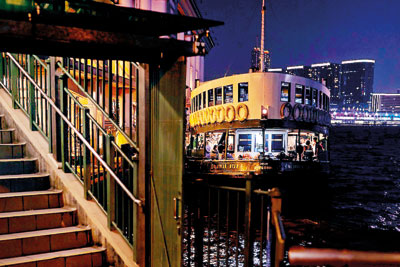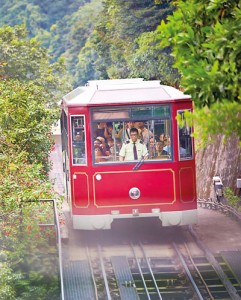Exploring a melting pot of culture

A âmustâ while in Hong Kong: A ride on the Star Ferry
With Asian destinations gaining popularity as holiday hotspots, Hong Kong could easily be the Manhattan of Asia. From its ancient temples, awe-inspiring skyscrapers to its quaint trams, its colonial heritage blends seamlessly with its complex and intricate cosmopolitan lifestyle that drives this densely populated territory. For first timers or seasoned travellers, Hong Kong offers an adventure of discovery which goes beyond Disneyland. Whether one is passing through on matters of business or has just a few days to spare on transit, Hong Kong will not disappoint. Read on to find out more reasons to visit this bustling melting pot of culture.
Take in the sights
Visit The Peak by Peak Tram
Itâs often been said that should one have limited time to spend in Hong Kongâ The Peak is where one should spend it. Considered the highest point on Hong Kong Island, it was once an exclusive neighbourhood in colonial times. The cooler climes were one of the sought after destinations of the famous and the rich. Today, aside from the pleasant weather it is the breathtaking views across Victoria harbour that keep the constant stream of tourists flowing and the best way to get there is by Peak Tram.
A ride in the Peak Tram offers a stunning visual of Hong Kongâs skyscrapers that glide past the tram window as it presses forward at a steep incline as it makes its ascent to The Peak. Since 1888, The Peak Tram has silently served Hong Kong witnessing the cityâs many changes for more than a 100 years.
Once at the top, The Peak Tower offers a viewing area called the Sky Terrace 428, and as its name suggests, is located 428 metres above sea level making the platform the highest in Hong Kong with stunning panoramic views.
Fun Facts
* Â According to the Hong Kong Tourist Board, the opening and closing scenes of âSoldier of Fortune,â set in 1955 starring Clark Gable, were filmed in the Peak Tram.
* Â A recent study conducted by The University of Hong Kong, revealed that passengers riding The Peak Tram experience a visual illusion. During the ascent uphill, the high rises seen on the right ride of the tram appear to lean toward The Peak. This illusion the study claimed is owing to a change of the subjective vertical view caused by the tilted visual environment and along with the reclining position of travellers inside the tram. The study was published in 2013 in the journal of Psychological Science.
Man Mo Temple
A declared monument, Man Mo Temple is considered as one of Hong Kongâs oldest temples. The Temple is dedicated to two gods – the God of literature âManâ, who holds a writing brush, and the God of war âMoâ who wields a sword. The temple was built in the Qing dynasty by wealthy Chinese merchants. Besides being a place of worship, the temple also served as a place of arbitration for local disputes in the days gone by between the Chinese and the colonialists.
On entering the temple, visitors will notice its smoky incensed air which emanates from incensed coils hung in spirals and suspended from the roof. The incense coils are kept alight as offerings by worshippers.
Interesting fact : It is said that oaths taken at this temple were often accepted by the colonial government accompanied by the ritual beheading of a rooster.
Cat Street
Just close by to Man Mo Temple is Upper Lascar Row, also referred to by locals as âCat Streetâ. It is a pedestrian-only lane with antique sellers and stalls offering curious items, handmade jewellery and ancient coins. For tourists itâs an interesting place to mingle about and pick up a few trinkets or two, however, most of the memorabilia is claimed to be mass-produced.
Hop aboard a âDing Dingâ
The tram system in Hong Kong has been one of the cityâs earliest forms of affordable public transport and is a major tourist attraction to date. Trams itself are fondly referred to as âDing Dingâ by Hong Kong dwellers for the characteristic sound the tram bell makes to warn pedestrians to make way. With time the term âTake ding dingâ has come to mean travel by tram.
Visitors to Hong Kong can indulge in a bit of nostalgia by taking a Hong Kong Tramwaysâ TramOramic tour to explore the cityâs old corners as well as its modern marvels. The tram is a 1920s styled double deck tram and offers a unique experience. The vintage cabin at the bottom deck is a page out of history with a small picture gallery of tram life years ago.
The front seats of the upper deck provide amazing views of the town while the tram trundles along its well preserved tracks. On board tourists can listen to pre-recorded voicings that point out landmarks and describe local life and tram history along the way on headsets provided on tour.
Fun Facts
* Â Hong Kongâs tram system at its inception used electric trams and horse or steam power has never been used.
* Red Light Meals – During days of old, tram drivers were allocated little time for lunch breaks. As such most drivers would make the best use of time spent waiting at a red light to eat part of their meal quickly before the signal turned green. This practice would be continued at red lights till the meal was consumed. Since then an impromptu, hurried meal is commonly referred to as a âred light meal.â
Star Ferry ride across Victoria Harbour
Another bit of nostalgia to experience while in Hong Kong is a ride on its Star Ferry perhaps one of the most unique experiences to engage in while in the country. Since the 1800s the Star Ferry has been continuously ferrying passengers across Victoria Harbour between Tsim Sha Tsui, Kowloon and Hong Kong Island.
There are other means of travelling across the harbour that are perhaps faster but the picturesque view, the pleasant breeze all factor in to make it a far more beautiful experience. First timers are recommended to take the ferry in the evening as a light show commonly referred to as the âSymphony of lightsâ gets underway – with lights emanating from the surrounding skyscrapers – it makes for a memorable boating experience.
Fun fact
The Star Ferry crossing was rated by the National Geographic as one of 50 âplaces of a lifetimeâ.
The Old Clock Tower
While the Kowloon-Canton Railway terminal is no more, the old Clock Tower standing at 44 metres high and erected in 1915 is a reminder of the terminal. The clock tower is located on the south shore of Tsim Sha Tsui, Kowloon and is all that remains from the original site.
The clock tower is part of Hong Kongâs heritage and has been preserved as a Declared Monument and serves as a nostalgic reminder of its once golden age of steam.
In days gone by the clock tower was a unique landmark for Chinese immigrants who passed by it ready to begin new lives in Hong Kong and for those who looked for new beginnings in other parts of the world who travelled through the cityâs harbour – were greeted by the sighting of the Clock Tower.
1881 Heritage
For travellers keen to step into the past – a visit to â1881Heritageâ will transport them to Hong Kong of the Victorian-era. During the 1800s, this particular area was the headquarters of the Hong Kong Marine Police. Several buildings in the vicinity and artifacts of historical interest have been restored. The site features a heritage hotel, a shopping mall and an exhibition hall.
1881 Heritage combines historical attractions along with contemporary activities â here visitors can shop for high end fashion brands and enjoy fine dining on the same grounds where once pirates were incarcerated.
Fun Fact
Among the Declared Monuments on the site is The Time Ball Tower. From the 1800s to 1900s, this tower helped ships in the Victoria Harbour recalibrate their chronometers. Many vessels arrived in Hong Kong after long voyages, after which their chronometers would have lost accuracy. The ball mounted on the pole in this tower is said to have been raised manually every morning and along with data from the Hong Kong Observatory â the ball was dropped at 1 p.m. every day. As the tower was in full view of the harbour the act of dropping the ball was a sign for ships to begin recalibrating their chronometers before they departed Hong Kong for other shores.
Stanley Market

Up, up and away to the Peak
Stanley Market located in the quaint village of Stanley on Hong Kong Islandâs southern coast is a huge draw for locals and tourists. The market offers up a range of items for sale including accessories, jewellery, home furnishings, souvenirs, ornaments and oriental knick-knacks sold amidst a picturesque interconnected pathway of lanes.
When in Hong Kong – Etiquette and home-grown remedies
* Â Following the outbreak of SARS, it is considered polite if one has a cold, to wear a facemask. Travellers shouldnât be alarmed if their temperature is checked at the airport randomly while cough etiquette hints are highlighted on certain public transport terminals.
* Â While some tourists may not be in Hong Kong on business there will be times when someone will present their business card. It is considered polite to receive the card with both hands respectfully.
*  Feeling under the weather? Hong Kong dwellers swear by their hot fermented Coca Cola drink. Yes, the beverage that is readily available as a soft drink is used to treat the common cold and symptoms of fever. One prepares the remedy by pouring Coca-Cola into a pan and boiling it together with slices of ginger and lemon. The drink is consumed piping hot. Bon Appétit.
 (The writer was a part of a media familiarization tour to Hong Kong organized by Cathay Pacific Airlines in partnership with East, Hong Kong)
Follow the Sunday Times for part II next week for places to eat and stay in Hong Kong.


